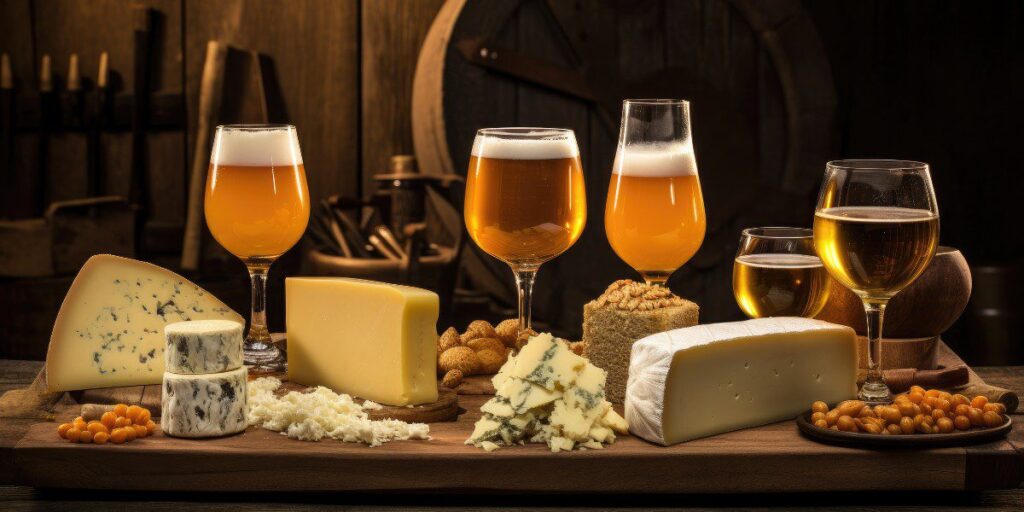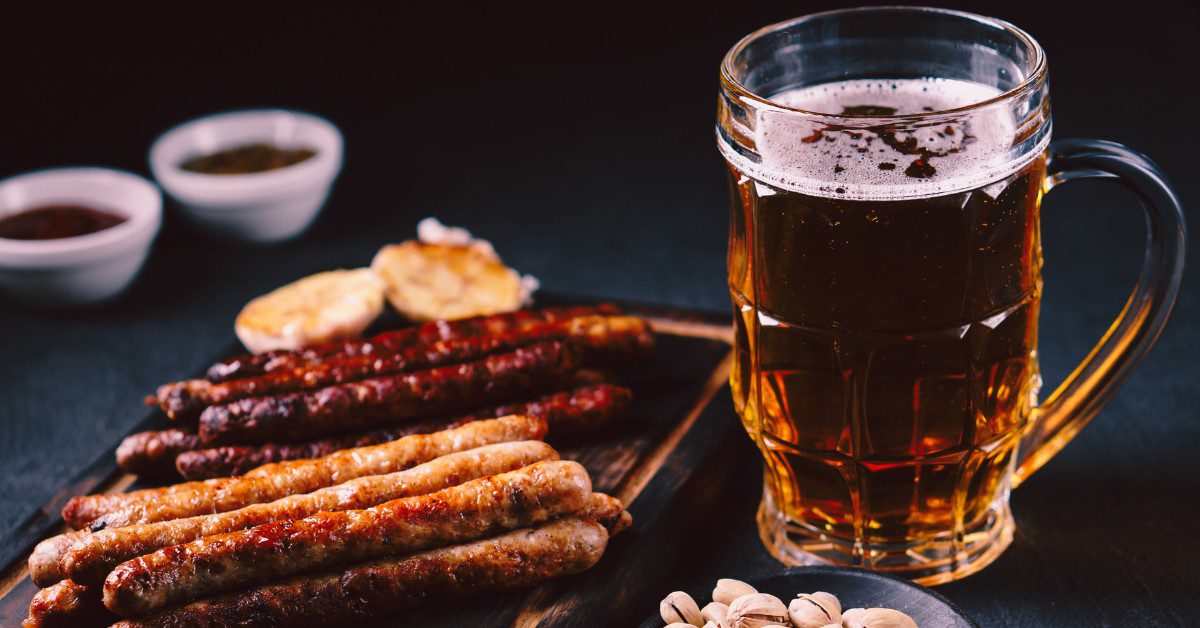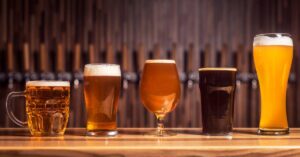When it comes to enhancing your dining experience, the right beer and food pairing can elevate a simple meal to a memorable event. Understanding how different beer styles complement various food flavors isn’t just for the culinary experts; it’s knowledge any enthusiast can enjoy. In this guide, we’ll explore the art of pairing beer with food, offering you insights and tips to transform your next meal into a gourmet experience.
Pairing beer with food is akin to finding harmony in a symphony; each element should enhance the other, creating a balanced and enjoyable experience.
For years, I’ve extolled the virtues of beer. I’d rather have a bottle of well-made ale or lager than a glass of wine, no matter how good. I’ve found beer capable of greater flavor and aroma, more complexity, and greater variety. Most surprising even to me is how well beer pairs up with food.
Also Read
You must wonder how I can say this. First, you have to understand I’m not talking about mainstream North American lager. I’m talking about well-made, craft-brewed ales and lagers, as well as traditional European beers. Although many wines will match up just fine with traditional fare, there are many foods wine just can’t handle. Spicy food, Asian cuisine, and creamy dishes are all poor matches for wine. As are cheeses and desserts. Beer can tackle these foods and more with grace and aplomb.
The Basics of Beer and Food Pairing
It’s possible to follow the same basic rules as you would for pairing wine and food. You want to consider the weight, acidity, and sweetness of the wine you’re pairing with your meal. With a few alterations, the same rules apply to your beer.
1) For red wine, substitute ale. For white wine, use lager.
All beer around the world is either ale or lager. Ale is fermented at warmer temperatures, resulting in a full-bodied beer with malt sweetness, a round finish, and maybe notes of fruit, bread, nuttiness, or caramel. Lager is brewed colder, giving a beer with less mouthfeel, a crisp, dry finish, a floral, hoppy aroma, and sometimes a gently bitter finish. Therefore, ales will stand up to heartier dishes based around full-flavored red meats. Lagers tend to marry their subtle, delicate flavors with chicken, pasta, thin soups, and other more delicate dishes.
2) Acidity in wine equals bitterness in beer.
When matching food and wine, dishes that have the acidity of lemon or tomato need an acidic wine to stand up to. Alternatively, wine’s acidity can be cut through creamy, fatty, salty, or spicy dishes. When using beer, bitterness will have the same effect. The bitterness of an English bitter or IPA can stimulate the appetite before a meal. Like a wine’s tannins or acidity, bitterness adds backbone and balance to an ale or lager. Bitterness can also cut through the fattiness of roast or the creaminess of a cream-based soup or pasta sauce, leaving the palate refreshed for the next bite.
3) Complement or contrast.
Ideal food and beverage pairings are built on this principle. Complementing flavors is easy. Beef, pork, or turkey roasted in the oven has a deep, caramelized flavor. IPA, brown ales, porters, and bocks have similar caramel flavors. The spicy, herbal flavors of Belgian tripels or abbey-style ales can go brilliantly with sausage, stuffing, or roast chicken. Contrast can be more of a challenge, though. The best advice I can give here is to experiment and not serve beers whose flavor is too different than the meal.
4) Dessert
The common wisdom is to keep beer sweeter than desserts. If the dessert is sweeter, beer tends to taste thin and sour by comparison. Fruit beer, especially Belgian lamb, goes perfectly with fruit-based desserts. Chocolate dessert, however, is the exception to the above rule. Because many chocolate desserts contain some bitterness, they can pair up with all but the most bitter beers. Stout is often the most perfect beer to have with chocolate desserts. The roasted coffee notes present in a good stout play perfectly off the intensity of the chocolate.
5) Cheese
When it comes to cheese, beer comes to the rescue when wine falls flat. Wine and cheese don’t work because cheese coats the palate, blunting the taste of the wine. One reason beer matches so well with cheese is its carbonation. The fine, pinpoint carbonation of a finely crafted beer scrubs your palate clean after each bite. Thus, your taste buds are left free to enjoy the beer’s full flavor. Most often, beer’s maltiness will pair nicely with cheese.

Beer’s bready flavors and fruity esters pair up with cheese’s nuttiness or acidity as well. Finally, when it comes to funkier cheeses, try Belgian ales or French biere de garde.
Practical Beer and Food Pairing Tips
Start Simple: Begin with pairings that are widely recognized for their compatibility, such as a hoppy IPA with spicy food. The bitterness of the IPA contrasts with the spice, balancing the heat.
Seasonal Pairings: Consider the season when choosing your pairing. A refreshing lager might be perfect for a summer barbecue, while a rich stout could be the ideal companion for a winter stew.
Don’t be afraid to try new combinations. The world of beer is vast, and with craft breweries experimenting with flavors, there are endless possibilities for unique pairings.
Examples to Inspire Your Next Meal
- Seafood and Wheat Beer: The light, often citrusy flavors of wheat beers, like a Belgian Wit, complement the delicate flavors of seafood, enhancing without overpowering.
- Barbecue and Smoky Beers: Smoked beers or those with a hint of smokiness can stand up to the robust flavors of barbecue, echoing the char and depth of the food.
- Cheese and Farmhouse Ales: The earthy notes of farmhouse ales or saisons bring out the richness in a variety of cheeses, making for a sophisticated pairing.
- Desserts and Fruit Beers: The natural sweetness and acidity of fruit beers can cut through the richness of desserts, especially those with chocolate or fruit-based dishes.
To master pairing, it helps to understand the basic flavor profiles of beer: sweet, sour, salty, bitter, and umami. Each beer style has a dominant flavor profile, which can guide you in selecting a dish that either complements or contrasts with it. For example, the bitterness of an American Pale Ale contrasts nicely with the sweetness of a caramel dessert, while the umami flavor of a grilled steak is complemented by the maltiness of a brown ale.
Texture plays a significant role in pairing. The carbonation in beer can act as a palate cleanser, cutting through the richness of oily or fatty foods. A beer with high carbonation, like a German Pilsner, can refresh your palate after each bite of a rich, creamy dish, making each mouthful as enjoyable as the first.
Beer and food pairing is an art that invites experimentation and personal preference. There are no hard and fast rules, only guidelines to help you start your journey. Whether you’re dining out or cooking at home, take the opportunity to explore how different beers interact with your meals. With practice, you’ll develop a deeper appreciation for the nuances of both beer and food, turning every meal into an adventure. Remember, the best pairing is one that brings you joy. Cheers to your culinary explorations!













